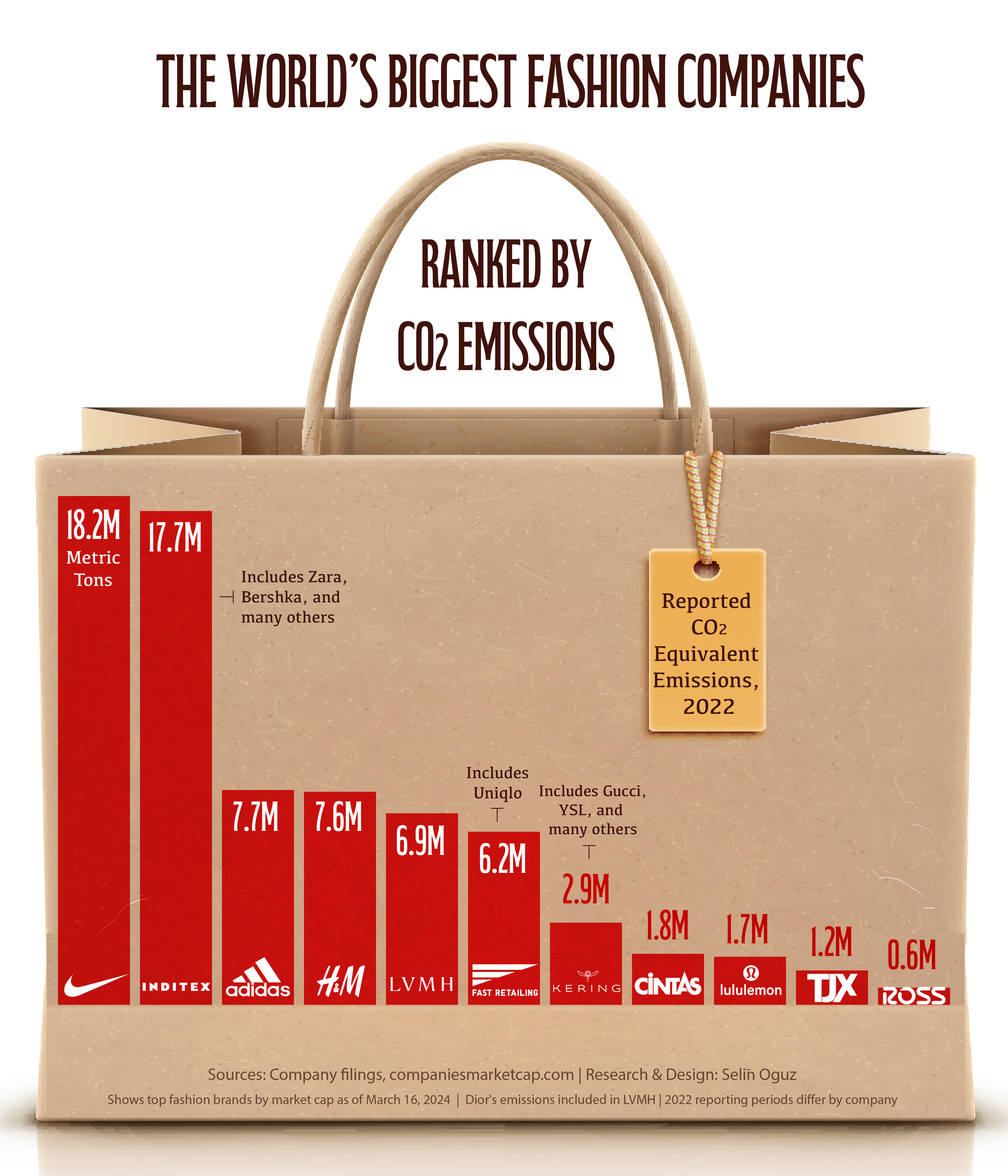![]()
See this visualization first on the Voronoi app.

CO₂ Emissions of the World’s Biggest Fashion Brands
This was originally posted on our Voronoi app. Download the app for free on iOS or Android and discover incredible data-driven charts from a variety of trusted sources.
The global fashion industry is responsible for significant CO₂ emissions, water consumption, and landfill waste, according to the UN Environment Programme.
This graphic by Selin Oğuz explores one aspect of that environmental footprint—CO₂ emissions—by visualizing the emissions of the world’s largest publicly-listed fashion companies, using their company sustainability reports.
What Are The World’s Biggest Fashion Brands?
Here are the world’s largest publicly listed fashion companies by market cap as of March 16, 2024, and some of the brand names in their arsenals.
| Company | Select owned companies |
|---|---|
| LVMH | Louis Vuitton, Dior, GIVENCHY |
| Inditex | Zara, Pull&Bear, Massimo Dutti |
| Nike | Converse, Jordan |
| TJX Companies | T.J. Maxx, Marshalls, HomeGoods |
| Fast Retailing | Uniqlo |
| Cintas | / |
| Lululemon | / |
| Kering | Gucci, Saint Laurent, Bottega Veneta |
| Ross Stores | Ross Dress for Less |
| Adidas | Runtastic |
| H&M | COS, ARKET, H&M Home |
Together, the above companies are worth more than $1.2 trillion in market capitalization. They also accounted for 73 million metric tons of CO₂ equivalent (CO₂e) emissions in 2022, which is comparable to Morocco’s total emissions in 2023.
Carbon Footprints of the Fashion Giants
In 2022, Nike, Inditex, and Adidas were among the largest contributors to emissions worldwide, among fashion companies.
A significant amount of this consisted of scope 3 emissions, which are indirect emissions that occur up and downstream of a company’s operations. Some examples of scope 3 emissions are those resulting from the production of raw materials and disposal of products after use.
| Company | Reporting time frame | Scope 1 Emissions | Scope 2 Emissions | Scope 3 Emissions | Total Emissions (Metric tons of CO₂e) |
|---|---|---|---|---|---|
| Nike | June 1, 2021–May 31, 2022 | 50,868 | 248,935 | 17,922,226 | 18,222,029 |
| Inditex | February 1, 2022–January 31, 2023 | 11,232 | 451,430 | 17,223,486 | 17,686,148 |
| Adidas | January 1, 2022–December 31, 2022 | 21,856 | 142,293 | 7,527,498 | 7,691,647 |
| H&M | December 1, 2021–November 30, 2022 | 23,056 | 511,533 | 7,092,988 | 7,627,577 |
| LVMH | January 1, 2022–December 31, 2022 | 67,393 | 654,790 | 6,135,000 | 6,857,183 |
| Fast Retailing | September 1, 2021–August 31, 2022 | 9,738 | 445,160 | 5,740,872 | 6,195,770 |
| Kering | January 1, 2022–December 31, 2022 | 21,660 | 105,958 | 2,813,225 | 2,940,843 |
| Cintas | June 1, 2021–May 31, 2022 | Breakdown unavailable | Breakdown unavailable | Breakdown unavailable | 1,823,972 |
| lululemon | January 1, 2022–December 31, 2022 | 3,910 | 24,950 | 1,691,008 | 1,719,868 |
| TJX Companies | February 1, 2022–January 31, 2023 | 128,450 | 1,039,219 | 61,800 | 1,229,469 |
| Ross Stores | February 1, 2022–January 31, 2023 | 29,832 | 481,229 | 100,604 | 611,665 |
It’s important to note that scope 3 emissions are known for being difficult to measure. This may give way to the possibility that some companies present underreported numbers in their sustainability reports.
The post Carbon Emissions of the World’s Biggest Fashion Brands appeared first on Visual Capitalist.